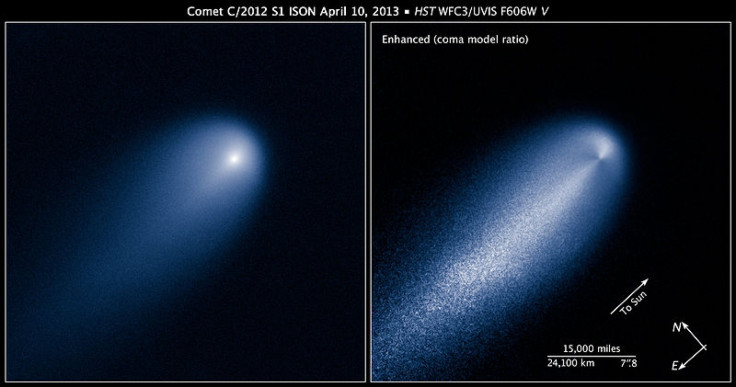Comet ISON May Be Disintegrating,The ‘Comet Of The Century’ Could Prove To Be A Dud
Comet ISON may wind up disappointing skywatchers hoping for the supposed “comet of the century.” Comet C/2012 S1 most recently passed Mars, and new data suggests it could be disintegrating.

Colombian astronomer Ignacio Ferrin, from the Group of Computational Physics and Astrophysics, FACom, said Comet ISON appears to be beginning to fall apart. Ferrin is using “secular light curves” to detail the brightness history of a comet. Comparing ISON’s light curves with eight other comets that disintegrated, Ferrin believes ISON will soon “fizzle” out. He said in a statement, “The light curve of the comet exhibited a slowdown event characterized by a constant brightness with no indication of a brightness increase tendency.”
Comet ISON, or C/2012 S1, was discovered in 2012 and is considered a sun-grazing comet, as it will pass very close to the sun. Around November, ISON was expected to be so bright that it would be visible in broad daylight. NASA production editor Tony Phillips had said, “If the comet survives the encounter, it could emerge glowing as brightly as the moon, visible near the sun in the blue daylight sky. The comet's dusty tail stretching into the night would create a worldwide sensation.”

According to Ferrin, the slowdown of ISON started on Jan. 13, 2013, and continued through the last observations made in September. For nine months, ISON’s brightness has remained constant, and that’s a troubling sign for the comet’s survival.
ISON has been a tricky comet to understand ever since it was discovered, reports Space.com. The surface of the comet had a thin layer of material that was vaporized well before it approached the sun, which could have led to a false understanding of its size and activity. The comet was supposed to receive a “kick start” from the sun and increase in brightness over the summer, but that never happened.
Ferrin said the ISON’s light curve was similar to other comets, comet Tabur, C/1996 Q1, and comet Hoenig, C/2002 O4, that disintegrated. Other factors, including a large decrease in magnitude and an increase in temperature that was not accompanied by a boost in brightness, have led Ferrin to believe ISON is in the “danger zone.” The comet will need to survive a trip around the sun around Nov. 21 to Nov. 30, prior to being visible on Earth, and observations in the coming weeks will help determine the possibility of ISON breaking up.
© Copyright IBTimes 2024. All rights reserved.






















